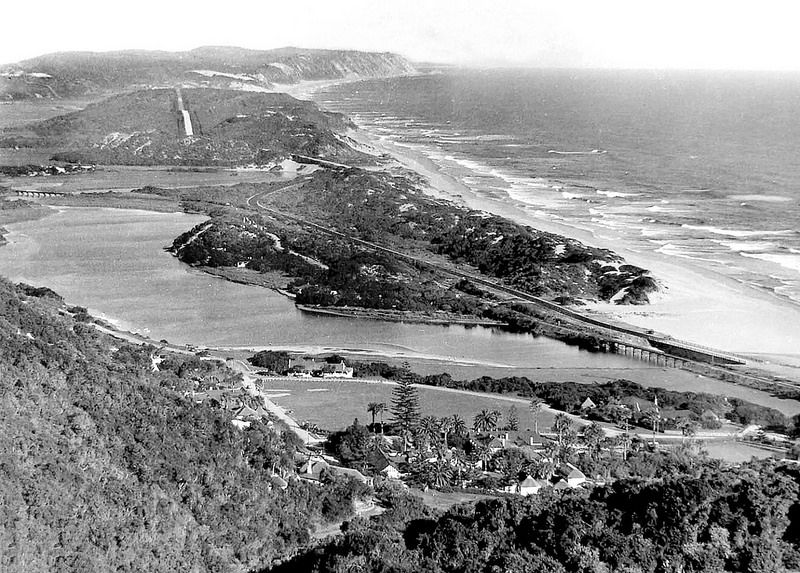by Hugo Leggat
There is increasing evidence that the coastal plains of southern Africa were the early
home to modern man, Homo sapiens. From here some would have moved out of Africa, ultimately to people the world. Others remained here and their descendants became the hunter-gatherers known to us as San or Bushmen. Figuratively, they trod lightly on the earth and the soft sands of the Wilderness soils contains little of their story but the tale is there to be read in the coastal shell middens, certain caves and the pictorial record in the rock art of the mountains.
Later still, the Khoekhoe appeared with their sheep and cattle and it is they who first
appear in the written record when Batholomeu Dias rounded the Cape in 1488 and,
sighting land near Mossel Bay, mentioned “the many cows, watched by their herdsmen.”
Even after the Dutch settlement at the Cape in 1652, it would be more than a century
before settlers moved into the area which we call Wilderness. The deep gorges of the
Kaaimans and Touw Rivers were always a difficult obstacle to ox wagons and it was only the building of a proper road to Knysna in the late 1860s that opened the lakes area to settlement. This is the road now known as the Seven Passes Route. Although it generally kept to the heights near the foot of the Outeniqua Mountains, it did open the forests and, more particularly, made it much easier to get wheeled traffic through the river gorges.
In 1877 George Bennett of Liverpool bought land at the mouth of the Touw, built a house and laid out a farm which he named “The Wilderness”. George and Henrietta Bennett built up the farm over the next seven years and had a son and twin daughters before George died in his early thirties. It was a remote spot and Henrietta left to marry her late husband’s cousin in England. It was to be more than thirty-five years before the property again had a resident owner.
Until the end of the 19th century Henrietta’s family kept an eye on the property for her, sometimes letting the farmhouse. After the end of the South African War in 1902, The Wilderness was bought by a syndicate headed by Montagu White. He did not live there himself, using his other property “Fancourt”, but he was instrumental in getting the farmhouse running as a guest house. He built White’s Road at a reasonable gradient up the hills above the lagoon and, together with the arrival of the motor car, this put the place on the map.
White’s death in 1916, followed by the end of World War I two years later, brought a
new beginning to The Wilderness. The property was bought by Wilderness (1921) Ltd,
headed by Owen Grant. OG, as he was widely known, settled on the property and
immediately set about developing it as a seaside resort with a name that was soon to be known worldwide.
It is likely that the romantic legend of the foundation of The Wilderness was circulated at this time. In this story a young man meets the beautiful orphan Theresa and she, insisting on being taken away from “the hauntings of memory”, sang to him from Haydn’s Creation “..In the wilderness build me a nest, let me remain there forever at rest..”. They finally settled here after various trials, tribulations and adventures which included difficult and dangerous wagon journeys over the Outeniquas, the clearing of jungle and a wedding in which Theresa wore “an ancient bridal gown that once had graced her grandmother in the courts of France”! A great story, much better than much which fills many publicity brochures. Most who read it would never know that it was a total figment of the imagination.
By the end of the 1920s, the old farm buildings had been transformed into a proper hotel, roads had been laid out, plots had been sold and houses were being built. Many of the thatched rondavels in the village date from that era.
On top of all this, the railway from George to Knysna was opened in 1928 with The
Wilderness as the only station on the line between George and Knysna. As early as 1932, OG completed negotiations with Union Airways ( the predecessor of SAA ) whereby he hoped that the Wilderness would receive a tremendous impetus. Arrangements were made for an inclusive rate for Wilderness Hotel visitors coming by plane. In some ways much of the basis for the future development of the area was already in place by this time, but there was one exception. Apart from the three railway bridges, there was no proper crossing on the Touw, other than the bridge on the Seven Passes Road. All motor traffic between George and Knysna still travelled on the inland route.
Another World War had to be fought before the necessary machinery and finance could be directed to building the initial National Road network. By 1952 the N2 was at last opened and George and Knysna were linked by a tarred coastal road – in a sense the modern infrastructure was complete.
Until the coming of the new road, the focus of the village had been towards the lagoon, where the shop, post office and petrol pumps stood at the bottom of the village green.
Now all commercial activity swung round to be accessible to the highway.
More significant than this was the fact that now a vast new area was opened to
development. All the area known as Wilderness East began from this time, to be followed in due course by Kleinkrans and Die Duine. Fortunately, in the mid-1980s the proclamation of the Wilderness National Park placed limits on the destruction of the environment which is the greatest asset of the Wilderness.
